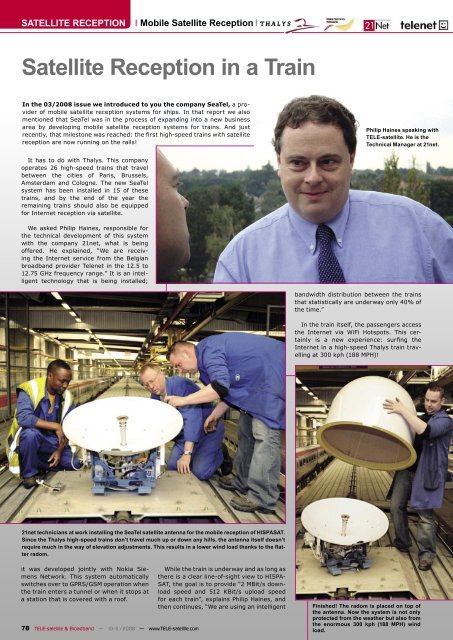SatcoDX - TELE-satellite International Magazine
SatcoDX - TELE-satellite International Magazine
SatcoDX - TELE-satellite International Magazine
You also want an ePaper? Increase the reach of your titles
YUMPU automatically turns print PDFs into web optimized ePapers that Google loves.
SATELLITE RECEPTION<br />
Mobile Satellite Reception<br />
Satellite Reception in a Train<br />
In the 03/2008 issue we introduced to you the company SeaTel, a provider<br />
of mobile <strong>satellite</strong> reception systems for ships. In that report we also<br />
mentioned that SeaTel was in the process of expanding into a new business<br />
area by developing mobile <strong>satellite</strong> reception systems for trains. And just<br />
recently, that milestone was reached: the first high-speed trains with <strong>satellite</strong><br />
reception are now running on the rails!<br />
It has to do with Thalys. This company<br />
operates 26 high-speed trains that travel<br />
between the cities of Paris, Brussels,<br />
Amsterdam and Cologne. The new SeaTel<br />
system has been installed in 15 of these<br />
trains, and by the end of the year the<br />
remaining trains should also be equipped<br />
for Internet reception via <strong>satellite</strong>.<br />
We asked Philip Haines, responsible for<br />
the technical development of this system<br />
with the company 21net, what is being<br />
offered. He explained, “We are receiving<br />
the Internet service from the Belgian<br />
broadband provider Telenet in the 12.5 to<br />
12.75 GHz frequency range.” It is an intelligent<br />
technology that is being installed;<br />
21net technicians at work installing the SeaTel <strong>satellite</strong> antenna for the mobile reception of HISPASAT.<br />
Since the Thalys high-speed trains don’t travel much up or down any hills, the antenna itself doesn’t<br />
require much in the way of elevation adjustments. This results in a lower wind load thanks to the flatter<br />
radom.<br />
it was developed jointly with Nokia Siemens<br />
Network. This system automatically<br />
switches over to GPRS/GSM operation when<br />
the train enters a tunnel or when it stops at<br />
a station that is covered with a roof.<br />
78 <strong>TELE</strong>-<strong>satellite</strong> & Broadband — 10-11/2008 — www.<strong>TELE</strong>-<strong>satellite</strong>.com<br />
While the train is underway and as long as<br />
there is a clear line-of-sight view to HISPA-<br />
SAT, the goal is to provide “2 MBit/s download<br />
speed and 512 KBit/s upload speed<br />
for each train”, explains Philip Haines, and<br />
then continues, “We are using an intelligent<br />
Philip Haines speaking with<br />
<strong>TELE</strong>-<strong>satellite</strong>. He is the<br />
Technical Manager at 21net.<br />
bandwidth distribution between the trains<br />
that statistically are underway only 40% of<br />
the time.”<br />
In the train itself, the passengers access<br />
the Internet via WiFi Hotspots. This certainly<br />
is a new experience: surfing the<br />
Internet in a high-speed Thalys train travelling<br />
at 300 kph (188 MPH)!<br />
Finished! The radom is placed on top of<br />
the antenna. Now the system is not only<br />
protected from the weather but also from<br />
the enormous 300 kph (188 MPH) wind<br />
load.

















